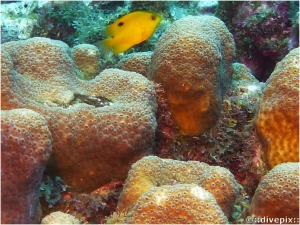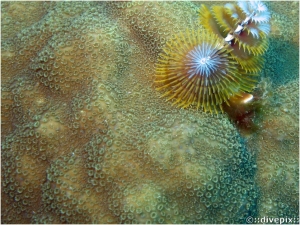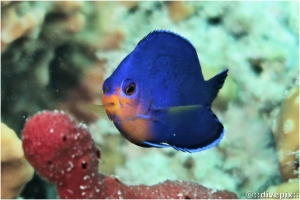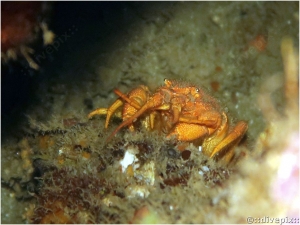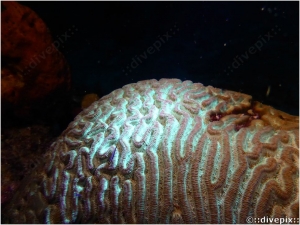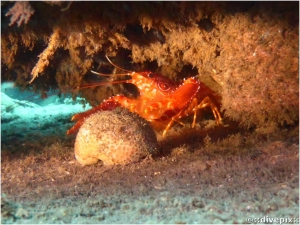| Aspect: | Greenish domed-shaped mass on which the tight colonies' brown ridges develop a semi-geometrical maze pattern. These boulders can grow into very large diameter mounds. |
| Population: | Common. |
| Notable feature: | The septa barely cross at the top of the ridges giving the impression that there is a dividing lane running atop the ridges. The slopes of the ridges do not run straight down to the valley but instead abruptly take a gentler slope to meet the opposite ridge slope. These green slopes themselves have a finely corrugated surface. |
| Environment: | Low-gradient slopes, starting from depths of a few metres. |
| Behaviour: | Polyps tend to emerge from the sides of the ridges at night only. |





Eric H. Biass
Lobed Star Coral
| Aspect: |
Groups of domed column stumps. Colours vary from green to ochre (more often) depending on light. Upper corallites are densely distributed and clearly prominent but not as tightly packed and large as Great Star Coral’s (q.v.). Tentacles usually extend at night, but may sometimes be partially extended during the day. Close-up views can be very deceptive: corallite/polyp diameter ranges from 3 to 5 mm. NOTE: The species was until recently known as Montastraea annularis. It is part of a group that includes another two variations now known as Orbicella franksii (formerly Montastraea franksii, or Boulder Star Coral) and Orbicella faveolata (or Mountainous Star Coral). All three belonged to the Faviidae family, but this has now also been renamed to Montastraeidae (in other words what used to be designation is now transferred to family name). This being said, the vernacular names in English and French have remained unchanged. |
| Population: | Common. |
| Notable feature: |
As the formation grows, corallites congregate towards the top of the stumps and as a consequence the lower vertical portions clearly tend to look abandoned and eventually eroded. |
| Environment: | Found depths of a few metres down to 30 metres. |
| Behaviour: | Polyps usually extend at night, but may sometimes be partially extended during the day. |
Blushing Star Coral
| Aspect: |
Colonies usually form a light brown mass covered in darker small-diameter corallites (less than 5mm in diameter). An encrusting coral, aspect and shape of a colony largely depend on substrate surface (can be flat or boulder). Corallite density may vary dramatically. |
| Population: |
Common, often home to fanworms and Christmas Tree Worms. |
| Notable feature: |
Tentacles are often extended during the day. Their retraction tends to cause a change of colour of the affected area, hence the English name given to this coral. The corallites and their septa barely emerge from the coral surface. |
| Environment: | Almost anywhere around Ilets Pigeon. |
| Behaviour: |
Tentacles immediately retract if approached too closely, which contributes to dramatically change the surface aspect and coral of the coral. |
Cherubfish
| Aspect: | Against all odds, this is not a Damselfish that made up for Carnival celebrations, but a genuine Angelfish and thus belongs to the Pomacanthidae family. Bright blue body and yellow face and chest. |
| Population: | So far unknown to the Ilets Pigeon reserve, but may be encountered - as is the case of this specimen - in the South of Guadeloupe around the Saintes islands. |
| Notable feature: | Blue ring around the eyes, and always has a blue tail: fins are bordered by a lighter blue line. |
| Environment: | Shallow waters |
| Behaviour: | Very wary. |
Maroon Sponge Zoanthid
| Aspect: |
Brown tentacles and body |
| Population: |
Common |
| Notable feature: |
Twelve widely spaced thin tentacles |
| Environment: |
Generally invades Brown Tube Sponges |
| Behaviour: | - |
Copper Lobster
| Aspect: |
Uniformly red-orange, with flatish head and body compared with other lobsters. |
| Population: | Not as widespread as other lobsters, but tends to be only visible at night. |
| Notable feature: | Quite hairy. |
| Environment: | Hides in small reef caves and recesses from which it barely emerges. |
| Behaviour: | Extremely shy. |
Boulder Brain Coral
Encrusting Fan-Leaf Alga
| Aspect: | Flat semi-circular blades (leaves), colour ranging from green to light brown to yellow. Grow flat and spread over relatively wide surfaces, leaves overlapping one another. |
| Population: | Widespread. |
| Notable feature: |
Belongs to the Brown Algae category in spite of its predominent green colour (algae are subdivided into four colours: Brown, Green, Red and Blue-Green. |
| Environment: | Grows over small flatfish surfaces at the foot of rockky formations. |
| Behaviour: | - |
Tube Anemone
| Aspect: |
Purple tentacles, relatively large fibrous tube. |
| Population: |
Uncommon. |
| Notable feature: | Settles in soft sandy terrain, hence often exposed tube. |
| Environment: |
Sandy bottom, moderate depths (10 metres) |
| Behaviour: | Shy, quickly retracts. |
Colon Gobie
| Aspect: |
Silvery body with scales giving a diamond appearance with randomly distributed darker scales, these being dark grey, black or brown. Two translucent dorsal fins. Spotted eye “bezel”, with forward spots larger than the others. |
| Population: |
Not as common as almost ubiquitous peppermint goby. |
| Notable feature: |
Distinguished from other similar gobies by two superimposed dark spots at the base of pectoral fin, plus vertical bar at base of tail fin. |
| Environment: |
Sandy bottom, moderate depths (10 metres) |
| Behaviour: | Shy, hence difficult to photograph. |
Flaming Reef Lobster
| Aspect: |
A bright red small lobster immediately distinguishable by a white “bull’s eye”-like marking on the forward side of its rostrum, it also features orange bands on its claws and legs. The sharper edges of its claws also carry a line of white spikes. |
| Population: |
Not only was it totally unknown to the region until Winter 2017-2018, the Flaming Reef Lobster also appears to be the first specimen from the Enoplometopidea family to have settled in this region, most probably “imported” from the south by hurricane Irma in September 2017. |
| Notable feature: | Crab-like claws identifies it as an Asticea as opposed to a Palinura, like the other three most common species of lobsters found in the region (Caribbean Spiny Lobster, Spotted Spiny Lobster and Red Banded Lobster). |
| Environment: | Specimen featured here was found hiding in a gunwale recess on the Franjack wreck at a depth of 20 metres (approx 60 feet). |
| Behaviour: | Extremely shy. |



